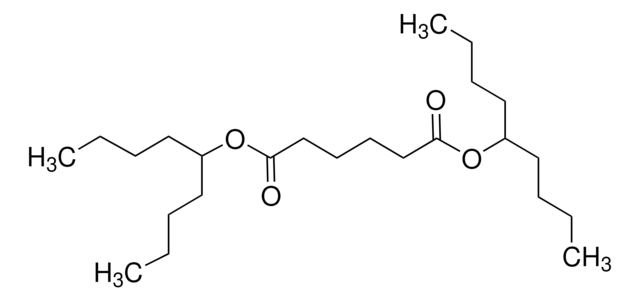84818
Bis(2-ethylhexyl) sebacate
Selectophore™, ≥97.0%
동의어(들):
Di(2-ethylhexyl) sebacate, Sebacic acid di(2-ethylhexyl) ester, ‘Dioctyl’ sebacate
로그인조직 및 계약 가격 보기
모든 사진(1)
About This Item
Linear Formula:
[-(CH2)4CO2CH2CH(C2H5)(CH2)3CH3]2
CAS Number:
Molecular Weight:
426.67
Beilstein:
1806504
EC Number:
MDL number:
UNSPSC 코드:
26111700
PubChem Substance ID:
NACRES:
NB.61
추천 제품
Grade
for ion-selective electrodes
Quality Level
제품 라인
Selectophore™
분석
≥97.0% (GC)
≥97.0%
형태
liquid
refractive index
n20/D 1.450 (lit.)
bp
212 °C/1 mmHg (lit.)
density
0.914 g/mL at 25 °C (lit.)
SMILES string
CCCCC(CC)COC(=O)CCCCCCCCC(=O)OCC(CC)CCCC
InChI
1S/C26H50O4/c1-5-9-17-23(7-3)21-29-25(27)19-15-13-11-12-14-16-20-26(28)30-22-24(8-4)18-10-6-2/h23-24H,5-22H2,1-4H3
InChI key
VJHINFRRDQUWOJ-UHFFFAOYSA-N
유사한 제품을 찾으십니까? 방문 제품 비교 안내
일반 설명
Bis(2-ethylhexyl) sebacate (BEHS) is a plasticizer widely used in preparing ion-selective electrodes.
Visit our Sensor Applications portal to learn more.
애플리케이션
BEHS was used in preparing PVC-membrane anionic-surfactants-selective electrodes.
법적 정보
Selectophore is a trademark of Merck KGaA, Darmstadt, Germany
Storage Class Code
10 - Combustible liquids
WGK
awg
개인 보호 장비
Eyeshields, Gloves
이미 열람한 고객
A new ion-selective electrode for anionic surfactants.
Segui, Ma Jesus, et al.
Talanta, 71.1, 333-338 (2007)
Mercury (II) ion-selective electrodes based on p-tert-butyl calix [4] crowns with imine units.
Mahajan, Rakesh Kumar, et al.
Analytical Sciences, 20.5, 811-814 (2004)
J Heyder et al.
Journal of applied physiology (Bethesda, Md. : 1985), 64(3), 1273-1278 (1988-03-01)
Convective gas mixing in the respiratory tract of 17 healthy male subjects was studied by an aerosol bolus technique. The monodisperse 1 micron di(2-ethylhexyl)sebacate droplets we used behaved as a nondiffusing gas. As the bolus was inspired to different depths
Guilherme J M Garcia et al.
Journal of aerosol medicine and pulmonary drug delivery, 22(2), 139-155 (2009-05-09)
Interindividual variability in nasal filtration is significant due to interindividual differences in nasal anatomy and breathing rate. Two important consequences arise from this variation among humans. First, devices for nasal drug delivery may furnish quite different doses in the nasal
J S Ilowite et al.
Archives of environmental health, 44(4), 267-273 (1989-07-01)
Mucociliary clearance was compared in three groups of normal subjects; each group inhaled a different type of aerosol (sebecate, iron oxide, and aqueous) labelled with 99Tc, to determine the relationship between deposition pattern and the subsequent total lung clearance. Standardization
자사의 과학자팀은 생명 과학, 재료 과학, 화학 합성, 크로마토그래피, 분석 및 기타 많은 영역을 포함한 모든 과학 분야에 경험이 있습니다..
고객지원팀으로 연락바랍니다.









![Sodium tetrakis[3,5-bis(trifluoromethyl)phenyl]borate Selectophore™](/deepweb/assets/sigmaaldrich/product/structures/251/439/7a621e74-bfd1-4a43-833c-09adfcc1e0b3/640/7a621e74-bfd1-4a43-833c-09adfcc1e0b3.png)
